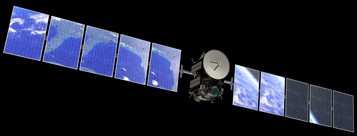Sun, Sep 02, 2012
Scheduled To Depart Vesta Asteroid September 5 On A 30 Month Journey To Ceres
NASA's Dawn spacecraft is on track to become the first probe to orbit and study two distant destinations to help scientists answer questions about the formation of our solar system. The spacecraft is scheduled to leave the giant asteroid Vesta on September 5 to start its 2 1/2-year journey to the dwarf planet Ceres.

Dawn began its 3-billion-mile odyssey to explore the two most massive objects in the main asteroid belt in 2007. Dawn arrived at Vesta in July 2011 and will reach Ceres in early 2015. These two members of the asteroid belt have been witness to much of our solar system's history. The valuable evidence Dawn gathered from examining the first of these cosmic fossils up close improved our understanding of asteroids and provided context for a future human mission to visit an asteroid.
The spacecraft will spiral away from Vesta as gently as it arrived, using a special, hyper-efficient system called ion propulsion. The ion propulsion system uses electricity to ionize xenon to generate thrust. The 12-inch-wide ion thrusters provide less power than conventional engines but can maintain thrust for months at a time. "Thrust is engaged and we now are climbing away from Vesta atop a blue-green pillar of xenon ions," said Marc Rayman, Dawn's chief engineer and mission director, at NASA's Jet Propulsion Laboratory (JPL) in Pasadena, Calif. "We are feeling somewhat wistful about concluding a fantastically productive and exciting exploration of Vesta, but now we have our sights set on dwarf planet Ceres."

Dawn provided close-up views of Vesta and unprecedented detail about the giant asteroid. Findings revealed that the asteroid had completely melted in the past, forming a layered body with an iron core. The spacecraft also revealed the collisions Vesta suffered in its southern hemisphere. The asteroid survived two colossal impacts in the last 2 billion years. Without Dawn, scientists would not have known about the dramatic troughs sculpted around Vesta, which are ripples from the two south polar impacts. "We went to Vesta to fill in the blanks of our knowledge about the early history of our solar system," said Christopher Russell, Dawn's principal investigator, based at the University of California, Los Angeles (UCLA). "Dawn has filled in those pages and more, revealing to us how special Vesta is as a survivor from the earliest days of the solar system. We now can say with certainty that Vesta resembles a small planet more closely than a typical asteroid."
JPL manages the mission to Vesta and Ceres for NASA's Science Mission Directorate in Washington. Dawn is a project of the directorate's Discovery Program, which is managed by NASA's Marshall Space Flight Center in Huntsville, AL.
(Images provided by NASA)
More News
Klyde Wonders If The 'New' SouthWest Can 'Out-Spirit' Spirit... FMI: www.klydemorris.com>[...]
From 2012 (YouTube Edition): Extensive Expertise in Backup Solutions Makes MCIA Uniquely Qualified In This Market There's no such thing, in aviation, as TOO much caution... hence t>[...]
Aero Linx: Historic Aircraft Association (HAA) The Historic Aircraft Association (HAA) was founded in 1979 with the aim of furthering the safe flying of historic aircraft in the UK>[...]
Jamming Denotes emissions that do not mimic Global Navigation Satellite System (GNSS) signals (e.g., GPS and WAAS), but rather interfere with the civil receiver's ability to acquir>[...]
"Respectfully, U.S. and European airlines should not be even contemplating the future purchase of airplanes from Chinese military companies...” Source: US Representative Raja>[...]
 Klyde Morris (05.02.25)
Klyde Morris (05.02.25) Classic Aero-TV: Introducing The MD302--Mid-Continent's Standby Attitude Module
Classic Aero-TV: Introducing The MD302--Mid-Continent's Standby Attitude Module ANN's Daily Aero-Linx (05.04.25)
ANN's Daily Aero-Linx (05.04.25) ANN's Daily Aero-Term (05.04.25): Jamming
ANN's Daily Aero-Term (05.04.25): Jamming Aero-News: Quote of the Day (05.04.25)
Aero-News: Quote of the Day (05.04.25)




